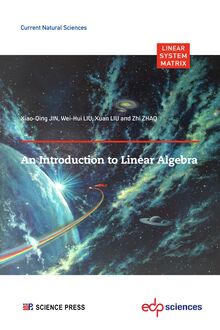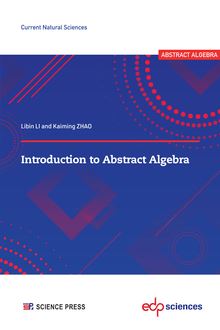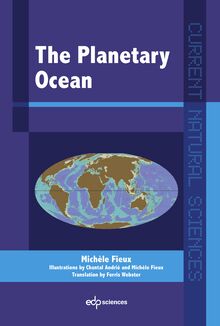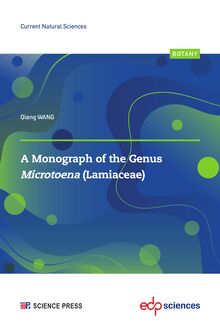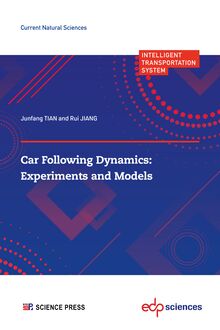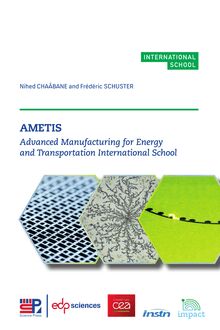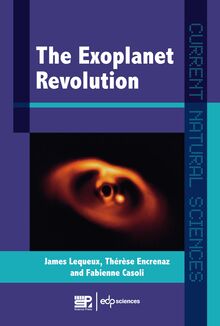Linkage Analysis and Gene Mapping , livre ebook
532
pages
English
Ebooks
2023
Obtenez un accès à la bibliothèque pour le consulter en ligne En savoir plus
Découvre YouScribe en t'inscrivant gratuitement
Découvre YouScribe en t'inscrivant gratuitement
532
pages
English
Ebooks
2023
Obtenez un accès à la bibliothèque pour le consulter en ligne En savoir plus
Publié par
Date de parution
07 juillet 2023
Nombre de lectures
3
EAN13
9782759830435
Langue
English
Poids de l'ouvrage
14 Mo
One major task of genetic studies is to construct the genetic map through linkage analysis, and then locate the genetic loci of important traits on the constructed linkage maps, identify favorable alleles which are of values to human beings, and investigate their biochemical pathways from genotype to phenotype.
This book presents the linkage analysis and gene mapping methodologies, which are applicable to self-pollinated, cross-pollinated, and asexual propagated species, and genetic populations derived from two homozygous parents, two heterozygous parents, and multiple homozygous parents. Chapter 1 in this book begins with genetic mating designs and various types of genetic populations, followed by the structure of commonly used populations and analysis methods of phenotypic data. In chapters 2 and 3, estimation of recombination frequency and construction of linkage map are introduced for twenty bi-parental populations. Chapter 4 deals with two classical gene mapping methods, where no background control is considered, while chapters 5 and 6 describe the inclusive composite interval mapping (ICIM) with background control. Chapter 7 is focused on populations derived from two heterozygous parents, which can be two individuals in a random mating population, two clonal cultivars, or two single crosses from four homozygous inbred lines. Chapter 8 provides knowledge on the pure-line progeny populations derived from four to eight homozygous parents. The last two chapters covers populations, methods and commonly asked questions in genetic mapping which cannot be included previously.
This book is intended for readers working on plant and animal genetics, population and quantitative genetics, and plant and animal breeding.
Preface..................................................... III
CHAPTER 1
Populations in Genetic Studies................................... 1
1.1 Commonly Used Populations in Genetic Studies ................. 2
1.1.1 Bi-Parental Populations.............................. 2
1.1.2 Multi-Parental Populations........................... 5
1.1.3 Considerations in Developing Genetic Populations .......... 9
1.2 Preliminary Analysis of Genotypic Data....................... 12
1.2.1 Collection and Coding of Genotypic Data................ 12
1.2.2 Gene Frequency and Genotypic Frequency................ 17
1.2.3 Fitness Test on Genotypic Frequencies................... 18
1.3 Genetic Effect and Genetic Variance.......................... 20
1.3.1 Calculation of Population Mean and Phenotypic Variance .... 20
1.3.2 One-Locus Additive and Dominance Model............... 23
1.3.3 Population Mean and Genetic Variance at One Locus ....... 24
1.4 ANOVA on Single Environment Trials........................ 27
1.4.1 Linear Decomposition on Phenotypic Observation .......... 27
1.4.2 Decomposition of Sum of Squares of Phenotypic Deviations ... 28
1.4.3 Single Environmental ANOVA on Rice Grain Length ........ 31
1.5 ANOVA on Multi-Environment Trials......................... 32
1.5.1 Linear Decomposition on Phenotypic Observation .......... 32
1.5.2 Decomposition of Sum of Squares of Phenotypic Deviations ... 33
1.5.3 Multi-Environmental ANOVA on Rice Grain Length ........ 38
1.6 Estimation of Genotypic Values and the Broad-Sense Heritability .... 39
1.6.1 Genotypic Values and Broad-Sense Heritability from Single Environmental Trials....................... 39
1.6.2 Genotypic Values and Broad-Sense Heritability from Multi-Environmental Trials....................... 41
1.6.3 Estimation of Genotypic Values Under Heterogeneous Error
Variances......................................... 42
Exercises................................................... 45
CHAPTER 2
Estimation of the Two-Point Recombination Frequencies ............... 51
2.1 Generation Transition Matrix............................... 51
2.1.1 Usefulness of the Transition Matrix in Linkage Analysis ...... 51
2.1.2 Transition Matrix of One Generation of Backcrossing ........ 53
2.1.3 Transition Matrix of One Generation of Selfing ............ 55
2.1.4 Transition Matrix of Doubled Haploid................... 58
2.1.5 Transition Matrix of Repeated Selfing................... 59
2.1.6 Expression of the Two-Locus Genotypic Frequencies in Matrix Format................................... 61
2.2 Theoretical Genotypic Frequencies at Two Loci ................. 62
2.2.1 Theoretical Frequencies of 10 Genotypes at Two Loci ....... 62
2.2.2 Theoretical Frequencies of 4 Homozygotes in Permanent Populations....................................... 65
2.2.3 Genotypic Frequencies of Two Co-Dominant Loci in Temporary Populations ............................65
2.2.4 Genotypic Frequencies of One Co-Dominant Locus and One Dominant Locus in Temporary Populations............... 69
2.2.5 Genotypic Frequencies of One Co-DominantLocus and One Recessive Locus in TemporaryPopulations................ 69
2.2.6 Genotypic Frequencies of Two DominantLoci in Temporary Populations....................................... 74
2.2.7 Genotypic Frequencies of One DominantLocus and One Recessive Locus in Temporary Populations................ 74
2.2.8 Genotypic Frequencies of Two Recessive Loci in Temporary Populations....................................... 77
2.3 Estimation of Two-Point Recombination Frequency .............. 77
2.3.1 Maximum Likelihood Estimation of Recombination Frequency in DH Populations.......................... 77
2.3.2 General Procedure on the Maximum Likelihood Estimation of Recombination Frequency.......................... 81
2.3.3 Estimation of Recombination Frequency Between One Co-Dominant and One Dominant Marker in F2 population.... 86
2.3.4 Initial Values in Newton Algorithm..................... 87
2.3.5 EM Algorithm in Estimating Recombination Frequency in F2 Populations .......................................90
2.3.6 Effects on the Estimation of Recombination Frequency from Segregation Distortion............................... 92
Exercises................................................... 95
CHAPTER 3
Three-Point Analysis and Linkage Map Construction.................. 101
3.1 Three-Point Analysis and MappingFunction.................... 102
3.1.1 Genetic Interference and Coefficient ofInterference ......... 102
3.1.2 Mapping Function.................................. 105
3.2 Construction of Genetic Linkage Maps........................ 107
3.2.1 Marker Grouping Algorithm........................... 107
3.2.2 Marker Ordering Algorithm........................... 111
3.2.3 Use of the k-Optimal Algorithm in Linkage Map Construction . 113
3.2.4 Rippling of the Ordered Markers....................... 117
3.2.5 Integration of Multiple Maps.......................... 118
3.3 Comparison of the Recombination FrequencyEstimation in Different Populations.............................................121
3.3.1 LOD Score in Testing the LinkageRelationship in Different Populations....................................... 121
3.3.2 Accuracy of the Estimated Recombination Frequency ........ 123
3.3.3 Least Population Size to Declare the Significant Linkage Relationship and Close Linkage........................ 124
3.4 Linkage Analysis in Random Mating Populations ................ 127
3.4.1 Linkage Dis-Equilibrium in Random Mating Populations ..... 127
3.4.2 Generation Transition Matrix from Diploid Genotypes to Haploid Gametes................................. 130
3.4.3 Gametic and Genotypic Frequencies in Populations After Several Generations of Random Mating.................. 132
Exercises................................................... 134
CHAPTER 4
Single Marker Analysis and Simple IntervalMapping .................. 139
4.1 Single Marker Analysis.................................... 140
4.1.1 Phenotypic Means of Different Genotypes at One Marker Locus............................................140
4.1.2 Single Marker Analysis by t-Test in Populations with Two Genotypes........................................ 143
4.1.3 Single Marker Analysis by t-Test in Populations with Three Genotypes........................................ 146
4.1.4 ANOVA in Single Marker Analysis in Populations with Three Genotypes........................................ 150
4.1.5 Likelihood Ratio Test in Single Marker Analysis............ 151
4.1.6 Problems with Single Marker Analysis................... 153
4.2 Simple Interval Mapping................................... 154
4.2.1 Frequencies of the QTL Genotypes in a Marker Interval ...... 154
4.2.2 Maximum Likelihood Estimation of Phenotypic Means of QTL Genotypes.................................. 161
4.2.3 Testing for the Existence of QTL....................... 166
4.2.4 Estimation of Genetic Effects of QTL and Its Contribution to Phenotypic Variance.............................. 167
4.2.5 Applications of Simple Interval Mapping in DH and F2 Populations....................................... 168
4.2.6 Phenomenon of ‘Ghost’ QTL in SimpleInterval Mapping .... 171
4.2.7 Other Problems with Simple Interval Mapping ............. 172
4.3 Threshold Values of LOD Score in QTL Mapping ................ 174
4.3.1 Significance Level and Critical Value of One Test Statistic .... 174
4.3.2 Distribution of the LRT Statistic at Single Scanning Positions in the Absence of Any QTL........................... 176
4.3.3 Factors Affecting the Distribution of the Genome-Wide Largest LOD Score................................. 177
4.3.4 Number of Effective Tests and the Empirical LOD Score Thresholds in QTL Mapping.......................... 180
4.3.5 Permutation Test and the Empirical LOD Score Thresholds in QTL Mapping................................... 184
Exercises................................................... 189
CHAPTER 5
Inclusive Composite Interval Mapping............................. 195
5.1 Importance of the Control on Background Genetic Variation in QTL Mapping............................................... 196
5.2 Inclusive Composite Interval Mapping in DH Populations .......... 199
5.2.1 Additive Genetic Model of One Single QTL............... 199
5.2.2 Additive Genetic Model for Multiple QTLs............... 201
5.2.3 One-Dimensional Scanning and HypothesisTesting for Additive QTLs.................................. 202
5.2.4 Application of ICIM in a DH Mapping Population in Barley . . 204
5.3 Inclusive Composite Interval Mapping in F2 Populations ........... 208
5.3.1 Additive and Dominant Model of One Single QTL .......... 208
5.3.2 Additive and Dominant Model for Multiple QTLs .......... 212
5.3.3 One-Dimensional Scanning and HypothesisTesting in Additive and Dominant QTL Mapping................ 213
5.3.4 Application of ICIM in an F2 Mapping Population .......... 214
5.4 Type II Error in Hypothesis Testing and Statistical Power in QTL Detection.............................................. 216
5.4.1 Type II Error and Statistical Power inHypothesis Testing .... 216
5.4.2 Probability of Two Types of Error and the Appropriate Sample Size....................................... 220
5.4.3 Distribution and Effect Models of QTLs Used in Power Analysis by Simulations.............................. 222
5.4.4 Calculation of the Detection Power and False Discovery Rate in QTL Mapping ...................................224
5.5 Comparison of IM and ICIM by Simulation.................... 230
5.5.1 QTL Detection Power and FDR from IM................. 230
5.5.2 QTL Detection Power and FDR from ICIM............... 232
5.5.3 Detection Powers Counted by Marker Intervals ............ 234
5.5.4 Suitable Population Size Required in QTLMapping ......... 235
5.6 Avoiding the Overfitting Problem in theFirst Step of Model
Selection in ICIM........................................ 237
Exercises ...................................................240
CHAPTER 6
QTL Mapping for Epistasis and Genotype-by-Environment Interaction ..... 245
6.1 Epistatic QTL Mapping in DH Populations.................... 246
6.1.1 Linear Regression in Epistatic QTL Mapping and the Statistical Properties................................ 246
6.1.2 Two-Dimensional Scanning on Di-GenicEpistatic QTLs ..... 248
6.1.3 Genetic Variance on Epistatic QTLs with Linkage .......... 253
6.1.4 Simulation Study on Epistatic QTL Mapping in DH Populations....................................... 254
6.2 Epistatic QTL Mapping in F2 Populations..................... 257
6.2.1 The Di-Genic Epistasis Model in F2 Populations ........... 257
6.2.2 Epistatic QTL Mapping Procedure in F2 Population ........ 258
6.2.3 Detection Power of Epistatic QTLs in F2Populations ....... 265
6.3 Genetic Analysis and Detection Power of the Most Common Di-Genic Interactions..................................... 268
6.3.1 Genetic Effects in Di-Genic Interactions.................. 268
6.3.2 Decomposition of Genetic Variance at the Presence of Di-Genic Epistasis................................ 270
6.3.3 Power Simulation of Epistatic QTL Mapping.............. 276
6.3.4 Issues in Epistatic QTL Mapping....................... 281
6.4 Mapping of the QTL by Environment Interactions ............... 282
6.4.1 Mapping of the Additive QTL byEnvironment Interactions ... 282
6.4.2 Mapping of the Epistatic QTL and Environment Interactions . 285
6.4.3 QTL and Environment Interactions in One Actual RIL
Population in Maize................................. 287
Exercises................................................... 291
CHAPTER 7
Genetic Analysis in Hybrid F1 of TwHeterozygous Parents and Double-Cross F1 of Four Homozygous Parents.................... 295
7.1 Linage Analysis in the Hybrid F1 Derivedfrom Two Heterozygous Parents................................................ 296
7.1.1 Categories of Polymorphism Markers ....................296
7.1.2 Unknown Linkage Phases in Heterozygous Parents and Genotypes in Their F1 Progenies at Two Loci.......... 298
7.1.3 Estimation of the Recombination Frequency Between Two Fully-Informative Markers............................ 299
7.1.4 Haploid Type Rebuilding in theHeterozygous Parents ....... 302
7.2 Estimation of the Recombination Frequencfor Incompletely Informative Markers...................................... 305
7.2.1 Theoretical Frequencies of Identifiable Genotypes Between the Complete Marker and Other Three Categoriesof Markers . 306
7.2.2 Theoretical Frequencies of Identifiable Genotypes Between Two Markers Belonging to Category II, III, or IV .......... 308
7.2.3 Theoretical Frequencies of Identifiable Genotypes Between Two Category IV Markers............................ 311
7.2.4 Haploid Type Rebuilding at the Presence of All Categories of Markers........................................ 316
7.3 Linkage Analysis in Double Cross F1 Derived from Four Pure-Line Parents................................................ 319
7.3.1 Marker Categories and Estimation of Recombination Frequency in the Double Cross F1 Population............. 319
7.3.2 Equivalence Between the Double Cross F1of Pure-Line Parents and Hybrid F1 of Heterozygous Parents............ 323
7.3.3 Genotypic Frequencies at Three Complete Markers ......... 325
7.3.4 Imputation of Incomplete and Missing Marker Information ... 327
7.4 QTL Mapping in the Double Cross F1Population Derived from Four Pure-Line Parents........................................ 331
7.4.1 One-QTL Genetic Model in Double Cross F1 Population ..... 332
7.4.2 The Linear Regression Model of the Phenotype on Marker Type for Multiple QTLs.............................. 335
7.4.3 Inclusive Composite Interval Mapping(ICIM) in the Double Cross F1 Population................................. 336
Exercises................................................... 338
CHAPTER 8
Genetic Analysis in Multi-Parental Pure-LineProgeny Populations........ 345
8.1 Linkage Analysis in Four-Parental Pure-LinePopulations .......... 346
8.1.1 Development Procedure and Marker Classification in Four-Parental Pure-Line Populations.................. 346
8.1.2 Theoretical Frequencies of Genotypes and Estimation of Recombination Frequency at Two Complete Loci......... 348
8.1.3 Estimation of the Recombination Frequency Involving Incomplete Markers................................. 355
8.1.4 Situations When Number of Inbred Parents Smaller Than Four.............................................359
8.2 Linkage Analysis in Eight-Parental Pure-Line Populations ......... 360
8.2.1 Development Procedure and Marker Classification in Eight-Parental Pure-Line Populations................. 360
8.2.2 Marker Classification and Genotypic Coding in Eight-Parental Pure-Line Populations................. 362
8.2.3 Theoretical Frequencies of Genotypes atTwo Complete Loci . . 363
8.2.4 Estimation of the Recombination Frequency Between Any Two Categories ofMarkers............................ 368
8.2.5 Situations When the Number of Inbred Parents Smaller Than Eight............................................ 370
8.3 QTL Mapping in Four-Parental Pure-LinePopulations ............ 370
8.3.1 Genetic Constitution at Three CompleteLoci ............. 371
8.3.2 Imputation of the Incomplete and Missing Marker Information....................................... 372
8.3.3 The Linear Regression Model of Phenotype on Marker Types. . 378
8.3.4 Inclusive Composite Interval Mapping(ICIM) in Four-Parental Pure-Line Populations.................. 380
8.4 QTL Mapping in Eight-Parental Pure-Line Populations ........... 383
8.4.1 Genetic Constitution at Three CompleteLoci ............. 383
8.4.2 The Linear Regression Model of Phenotypeon Marker Types. . 389
8.4.3 Inclusive Composite Interval Mapping(ICIM) in Eight-Parental Pure-Line Populations................. 391
Exercises................................................... 394
CHAPTER 9
QTL Mapping in Other Genetic Populations........................ 399
9.1 Selective Genotyping Analysis and Bulked Segregant Analysis....... 400
9.1.1 Statistical Principles of Selective Genotyping Analysis ....... 400
9.1.2 Likelihood Ratio Test and LOD Score Statistics from Selective Genotyping Analysis................................ 402
9.1.3 Bulked Segregant Analysis............................ 403
9.1.4 Problems with Selective Genotyping Analysis and Bulked Segregant Analysis.................................. 404
9.2 QTL Mapping in Populations of Chromosomal Segment Substitution Lines..................................................404
9.2.1 Characteristics of Chromosomal Segment Substitution Lines . . 404
9.2.2 Mapping Methods in Populations of Chromosomal Segment Substitution Lines.................................. 407
9.2.3 QTL Mapping for Grain Length in a CSSLPopulation in Rice........................................... 412
9.3 QTL Mapping in Genetic Populations of Multiple Parents Crossed with One Common Parent................................. 414
9.3.1 Generalized Linear Regression and Model Selection ......... 415
9.3.2 Parameter Estimation and HypothesisTesting in JICIM ..... 415
9.3.3 QTL Mapping for Flowering Time in an Arabidopsis NAM Population........................................ 417
9.4 Mendelization of Quantitative Trait Genes..................... 419
9.4.1 Preliminary Mapping of One QTL on GrainWidth of Rice in One RIL Population................................. 420
9.4.2 Validation of the Grain Width QTL byChromosomal Segment Substitution Lines........................... 421
9.4.3 Mendelization of a Stable QTL on Grain Width ............ 424
9.4.4 Fine Mapping and Functional Analysis of the Gene at a Stable Grain Width QTL.................................. 425
9.5 Association Mapping in Natural Populations.................... 427
9.5.1 Linkage Disequilibrium is the Prerequisite of Gene Mapping ... 427
9.5.2 Linkage Disequilibrium in Random Mating Populations ...... 429
9.5.3 Factors Influencing Linkage Disequilibrium ............... 432
9.5.4 Comparison of Linkage and Association Approaches in Gene
Mapping......................................... 435
Exercises................................................... 439
CHAPTER 10
More on the Frequently Asked Questions in QTLMapping .............. 443
10.1 Genetic Variance and Contribution to Phenotypic Variation of the Detected QTL.......................................... 443
10.1.1 Genetic Variance and Phenotypic Contribution from One QTL ..........................................443
10.1.2 Genetic Variance and PhenotypicContribution of Linked QTLs ..........................................445
10.1.3 Phenotypic Contribution and the QTL Detection Power.... 448
10.2 On the Use of Composite Traits in QTL Mapping ............... 450
10.2.1 Composite Traits and Their Applications in Genetic Studies and Breeding.............................. 450
10.2.2 QTL Mapping on Component and Composite Traits in One Maize RIL Population............................. 451
10.2.3 Genetic Effects and Genetic Variances on Composite Traits . 455
10.2.4 Power Analysis in QTL Mapping on Composite Traits ..... 461
10.2.5 Heritability of Composite Traits...................... 465
10.3 Effects on QTL Detection by the Increasein Marker Density ....... 470
10.3.1 Effects of Denser Markers on Independen tQTLs ......... 470
10.3.2 Effect of Denser Markers on Linked QTLs.............. 471
10.4 Imputation of Missing Marker Types and Their Effects in QTL Mapping in Bi-Parental Populations......................... 474
10.4.1 Imputation of Missing and Incomplete Marker Types ...... 474
10.4.2 QTLs on Plant Height in an F2 Population in Rice ........ 477
10.4.3 Effects of Missing Marker Types on QTLDetection ....... 479
10.5 Effects of Segregation Distortion on Genetic Studies ............. 481
10.5.1 Segregation Distortion Loci in One Rice F2 Population ..... 481
10.5.2 Effects of Segregation Distortion on QTL Mapping in Populations with Three Genotypes at Each Locus ...... 482
10.5.3 Genetic Distance That can be Affected by Segregation Distortion.......................................486
10.5.4 Effects of Segregation Distortion on QTLMapping in Populations with Two Genotypes at Each Locus....... 487
10.6 Non-Normality of the Phenotypic Distribution ................. 488
10.6.1 Phenotypic Model and Distribution of Quantitative Traits . . 488
10.6.2 QTL Mapping on Phenotypic Traits of the Non-Normal
Distributions.................................... 489
Exercises................................................... 492
References.................................................. 495
Index...................................................... 503
Appendix A: Journal Articles Making Up ThisBook .................. 509
Appendix B: Dissertations of Post-GraduatesMaking Up This Book ...... 513
Appendix C: Integrated Software Packages MakingUp This Book ........ 515
Publié par
Date de parution
07 juillet 2023
Nombre de lectures
3
EAN13
9782759830435
Langue
English
Poids de l'ouvrage
14 Mo
J. WANG, H. LI and
Linkage Analysis and Gene Mapping
L. ZHANG
Current Natural Sciences Current Natural Sciences
GENETICS GENETICSLinkage Analysis
and Gene Mapping
Jiankang WANG, Huihui LI and Luyan ZHANG
One major task of genetic studies is to construct the genetic
map through linkage analysis, and then locate the genetic loci of
important traits on the constructed linkage maps, identify favorable
alleles which are of values to human beings, and investigate their
Jiankang WANG, Huihui LI and Luyan ZHANG biochemical pathways from genotype to phenotype. This book
presents the linkage analysis and gene mapping methodologies,
which are applicable to self-pollinated, cross-pollinated, and
asexual propagated species, and genetic populations derived
from two homozygous parents, two heterozygous parents, and
multiple homozygous parents.
Chapter 1 in this book begins with genetic mating designs and Linkage Analysis
various types of genetic populations, followed by the structure of
commonly used populations and analysis methods of phenotypic
data. In chapters 2 and 3, estimation of recombination frequency and Gene Mapping
and construction of linkage map are introduced for twenty
bi-parental populations. Chapter 4 deals with two classical gene
mapping methods, where no background control is considered,
while chapters 5 and 6 describe the inclusive composite interval
mapping (ICIM) with background control. Chapter 7 is focused on
populations derived from two heterozygous parents, which can be
two individuals in a random mating population, two clonal cultivars,
or two single crosses from four homozygous inbred lines. Chapter 8
provides knowledge on the pure-line progeny populations derived
from four to eight homozygous parents. The last two chapters
covers populations, methods and commonly asked questions in
genetic mapping which cannot be included previously.
This book is intended for readers working on plant and animal
genetics, population and quantitative genetics, and plant and
animal breeding.
ISBN : 978-2-7598-3042-8
9 782759 830428
Price: xx €J. WANG, H. LI and
Linkage Analysis and Gene Mapping
L. ZHANG
Current Natural Sciences Current Natural Sciences
GENETICS GENETICSLinkage Analysis
and Gene Mapping
Jiankang WANG, Huihui LI and Luyan ZHANG
One major task of genetic studies is to construct the genetic
map through linkage analysis, and then locate the genetic loci of
important traits on the constructed linkage maps, identify favorable
alleles which are of values to human beings, and investigate their
Jiankang WANG, Huihui LI and Luyan ZHANG biochemical pathways from genotype to phenotype. This book
presents the linkage analysis and gene mapping methodologies,
which are applicable to self-pollinated, cross-pollinated, and
asexual propagated species, and genetic populations derived
from two homozygous parents, two heterozygous parents, and
multiple homozygous parents.
Chapter 1 in this book begins with genetic mating designs and Linkage Analysis
various types of genetic populations, followed by the structure of
commonly used populations and analysis methods of phenotypic
data. In chapters 2 and 3, estimation of recombination frequency and Gene Mapping
and construction of linkage map are introduced for twenty
bi-parental populations. Chapter 4 deals with two classical gene
mapping methods, where no background control is considered,
while chapters 5 and 6 describe the inclusive composite interval
mapping (ICIM) with background control. Chapter 7 is focused on
populations derived from two heterozygous parents, which can be
two individuals in a random mating population, two clonal cultivars,
or two single crosses from four homozygous inbred lines. Chapter 8
provides knowledge on the pure-line progeny populations derived
from four to eight homozygous parents. The last two chapters
covers populations, methods and commonly asked questions in
genetic mapping which cannot be included previously.
This book is intended for readers working on plant and animal
genetics, population and quantitative genetics, and plant and
animal breeding.
ISBN : 978-2-7598-3042-8
9 782759 830428Current Natural Sciences
Jiankang WANG, Huihui LI,
and Luyan ZHANG
Linkage Analysis
and Gene MappingPrinted in France
EDP Sciences – ISBN(print): 978-2-7598-3042-8 – ISBN(ebook): 978-2-7598-3043-5
DOI: 10.1051/978-2-7598-3042-8
All rights relative to translation, adaptation and reproductionbyany means whatsoever
arereserved,worldwide.Inaccordancewiththetermsofparagraphs2and3ofArticle41
of the French Act dated March 11, 1957, “copies or reproductions reserved strictly for
private use and not intended for collective use” and, on the other hand, analyses and
short quotations for example or illustrative purposes, are allowed. Otherwise, “any
representation or reproduction – whether in full or in part – without the consent of the
author or of his successors or assigns, is unlawful” (Article 40, paragraph 1). Any
representation or reproduction, by any means whatsoever, will therefore be deemed an
infringement of copyright punishable under Articles 425 and following of the French
Penal Code.
The printed edition is not for sale in Chinese mainland.
Science Press, EDP Sciences, 2023Preface
Genetics is the science on genes. One major task of genetics is to construct the
genetic map through linkage analysis, and then locate the genetic loci on important
traits on the constructed linkage maps, identify favorable alleles which are of value
to human beings, and investigate their biochemical pathway from genotype to
phenotype. This book is aimed to cover the linkage analysis and gene mapping
methodologies which are applicable to self-pollinated, cross-pollinated, and clonal
propagated species, and genetic populations derived from two homozygous parents,
two heterozygous parents, and multiple homozygous parents.
Genetically segregating populations is key to any genetic research. Chapter 1
beginswithmatingdesignsandvarioustypesofgeneticpopulations,followedbythe
structure of commonly used populations, collection and preliminary analysis of
genotypic data, collection and ANOVA on phenotypic data, and estimation of
variancecomponents,heritability,andgenotypicvalues.Inchapter2,theestimation
of two-point recombination frequency is introduced through the linkage analysis in
twenty bi-parental populations. Based on the estimated recombination frequency,
chapter 3 covers the construction of linkage maps, which can be roughly classified
intotwosteps, i.e.,groupingandordering.Introducedinchapter4aresinglemarker
analysis and simple interval mapping, without any background control.
Chapters 5 and 6 introduce the inclusive composite interval mapping (ICIM) with
backgroundcontrolforadditive(anddominant)QTLs,epistaticQTLs,andQTLby
environmentinteractions.Chapter7isonpopulationsderivedfromtwoheterozygous
parents, which may be two individuals in a random mating population, two clonal
cultivars,ortwosinglecrossesfromfourhomozygousinbredlines.Therefore,genetic
analysis methods introduced in this chapter are applicable to the full-sib families in
random mating species, F populations in asexually propagated species, and double1
cross F populations from four pure-line parents. Chapter 8 is focused on the1
pure-line progeny populations derived from four and eight homozygous parents.
Chapter9firstlyintroducestheanalysismethodsinselectedbi-parentalpopulations,
DOI: 10.1051/978-2-7598-3042-8.c901
Science Press, EDP Sciences, 2023IV Preface
populations consisting of chromosomal segment substitution lines (CSSL), and
nested association mapping (NAM) populations which are produced by crossing
multiple parents with one common parent. §9.4 outlines the general procedure for
finemapping,map-basedcloning,andfunctionalanalysisofquantitativetraitgenes,
and §9.5 introduces briefly the association mapping methodology applicable in
natural populations. The last chapter gives answers to frequentlyasked questions in
QTL mapping, which have not been fully investigated in previous chapters.
Most contents in this book come from the outcomes of our research activities at
the Quantitative Genetics Group, established in 2005 when the senior author
returnedbacktoChinaafterfiveyearsstaywiththeInternationalMaizeandWheat
Improvement Center (CIMMYT), headquartered in Mexico. The group is affiliated
with the Institute of Crop Sciences, Chinese Academy of Agricultural Sciences
(CAAS), working on three major areas: (1) breeding modelling, simulation, and
prediction; (2) genetic analysis of quantitative traits; and (3) genetics and breeding
softwareandtoolsdevelopment.AppendixAgivesalistofjournalarticlespublished
by the group, and appendix B gives a list of post-graduate dissertations, which are
relevant to various chapters and sections in this book. An efficient genetic analysis
cannot be possible without computer software packages. The group has spent
significant efforts and resources in developing and upgrading three user-friendly and
stand-alone packages, as listed in appendix C. QTL IciMapping is applicable for
twenty bi-parental populations derived from two homozygous parents, and NAM
and CSSL populations. GACD is applicable for F (or full-sib) families from two1
heterozygous parents, and double cross F populations from four homozygous par-1
ents. GAPL is applicable for the pure-line progeny populations from the
inter-mating of three to eight homozygous parents. The three integrated packages
are frequently mentioned where applicable to the contents of this book.
Without the substantial financial support received by the group, it would be
impossibleforthe groupto conduct theproductive researches. Neitherispossibleto
havesuchabook!Theauthorsareextremelygratefulforthelong-termsupportfrom
the Generation Challenge Program (https://www.generationcp.org/) and the
HarvestPlus Challenge Program (https://www.harvestplus.org/) of CGIAR
(https://www.cgiar.org/). The auth

